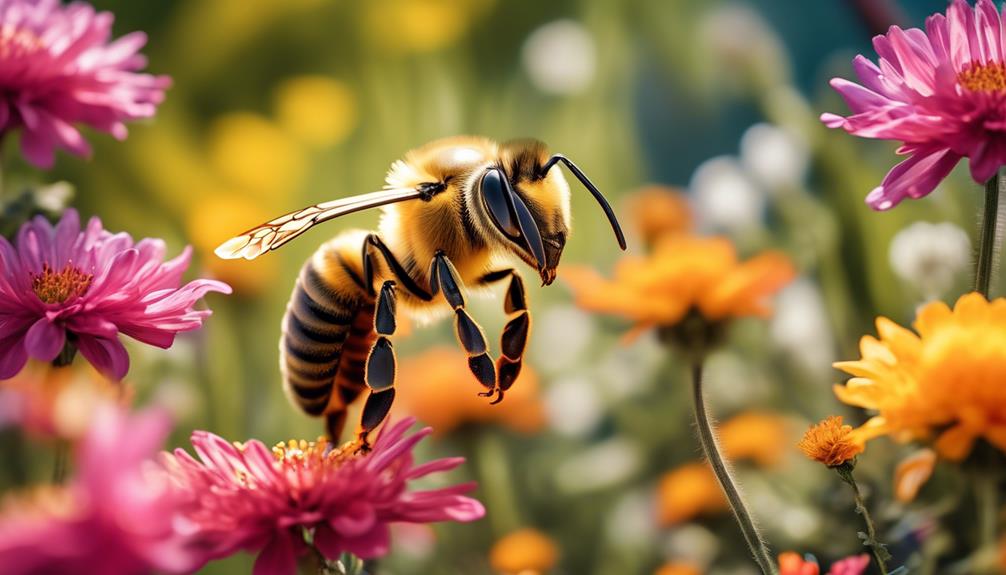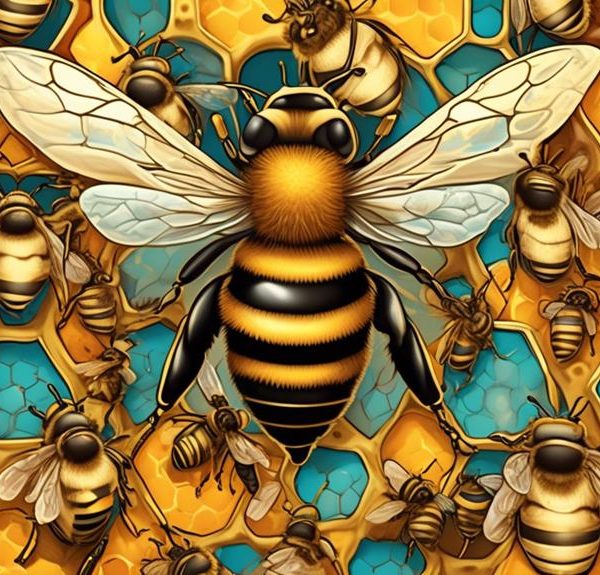Ponder the unexpected power play in nature as we delve into the surprising instances of bees overpowering birds.

Can Bees Kill Birds?
You've likely heard the saying 'the birds and the bees,' but have you ever considered the more literal, potentially deadly interactions between these two groups of creatures?
You might assume that the bird, larger and more mobile, would always come out on top, but nature's rulebook isn't so straightforward. Bees, with their stinging defense mechanisms and fierce protective instincts, might just have a trick or two up their tiny sleeves.
Would you believe that there are documented cases of bees dispatching birds? We'll explore this fascinating intersection of the animal kingdom to uncover the truth behind this unconventional warfare.
Key Takeaways
- Bees are not inherently aggressive but will defend their colony if they perceive a threat.
- Some bird species specifically target bees as prey, such as bee-eaters, honey buzzards, and woodpeckers.
- Bee-bird interactions can result in both fatal and non-fatal encounters, with some birds having techniques to neutralize bee defenses.
- The ecological impact of these interactions could disrupt ecosystem balance and have consequences for both bee and bird populations.
Understanding Bee Behavior

To truly grasp the potential for bees to harm birds, you first need to understand the instinctive behaviors of bees, which are primarily driven by their roles within the colony. Bees aren't inherently aggressive, but they'll defend their colony if they perceive a threat.
Worker bees, the majority in a colony, are responsible for various tasks including foraging for food, building and repairing the hive, and protecting it. They're equipped with stingers, used primarily for defense. When a bee stings, it releases pheromones that signal other bees to attack.
Drone bees, the males, don't have stingers so they can't harm birds. Their sole purpose is to mate with the queen.
The queen bee also has a stinger, but she doesn't use it for defense. Her role is to lay eggs and ensure the colony's survival.
It's important to note that bees are more likely to sting when they're away from the hive while foraging because they feel more vulnerable. Birds, being potential predators, can trigger this defensive behavior, especially if they approach a bee too closely or attempt to prey on it.
Birds as Potential Bee Predators

While many birds enjoy a diet rich in insects, several species are known to specifically target bees, posing a potential threat to their survival. You might be surprised to learn that birds such as bee-eaters, honey buzzards, and some species of woodpeckers have evolved to feed predominantly on bees and wasps.
Bee-eaters, as their name suggests, specialize in bee consumption. They've developed an extraordinary technique where they catch a bee, rub it against a hard surface to remove the stinger and then consume it.
Honey buzzards, on the other hand, raid bees' nests for honey and larvae. They've a thick layer of feathers that provides protection against bee stings.
Woodpeckers, specifically the European green woodpecker, are also known to target bee nests. They use their strong beaks to drill into the wood where bees have their nests and eat the larvae.
These bird species' predation behaviors can significantly impact local bee populations. Therefore, understanding this predator-prey relationship is crucial for implementing measures to protect bees, which play a vital role in pollination and maintaining biodiversity.
The Defense Mechanisms of Bees

In response to these avian threats, bees have evolved a variety of defense mechanisms that enable them to deter, and potentially harm, their bird predators. They've honed these tactics over millennia, with each generation improving on the last. You'll find their strategies to be both ingenious and varied, reflecting the complexity of their tiny, buzzing world.
Stinging is the most well-known bee defense. You're likely aware of the barbed stinger, a weapon they use only as a last resort, as it often results in their death. However, you may not know that some bee species can actually 'cook' their enemies. This process, called 'heat balling,' involves bees swarming around a threat and vibrating their bodies to generate heat, effectively cooking the threat alive.
Then there's their use of alarm pheromones, a chemical signal that alerts other bees to danger and prompts a collective defensive response. This tactic allows solitary bees to act as a united front against threats.
It's also worth mentioning that bees aren't defenseless in flight. They can execute evasive maneuvers to avoid capture, utilizing their agility and speed to outmaneuver their avian predators.
These defense mechanisms underscore the resilience and adaptability of bees in a world full of threats.
Documented Cases of Bee-Bird Interactions

You'll find that documented interactions between bees and birds, despite their rarity, offer fascinating insights into the dynamics of these unlikely adversaries. One noteworthy example is a 2017 report from Australia where a flock of Rainbow Bee-eaters was discovered dead, with autopsy revealing their stomachs full of bees. The birds' demise was attributed to bee venom; a clear indication of the lethal potential within a bee's sting.
Interestingly, not all bee-bird interactions result in fatalities. In fact, some birds have developed techniques to neutralize bee defenses. Consider the Honey Buzzard, a bird known to raid beehives for larvae. The bird's thick plumage and swift movements allow it to evade stings and feast on its prey.
However, caution must be exercised when interpreting these findings. While the accounts are intriguing, they represent isolated incidents and don't necessarily reflect the broader dynamics of bee-bird interactions. Further research is needed to understand the full spectrum of these encounters.
Ecological Impact and Conservation Concerns

Shifting our focus from individual incidents to broader ecological implications, it's pertinent to discuss the potential effects that these lethal bee-bird encounters could have on the balance of our ecosystems and the pressing conservation concerns that arise.
You see, bees and birds both play significant roles in our ecosystem. Bees pollinate our crops and flowers, while birds control insect populations and disperse seeds. Therefore, any drastic changes in their interactions could disrupt the balance of our ecosystems.
For instance, if bees begin killing birds at a significant rate, there could be a surge in insect populations and a decrease in seed dispersal due to fewer birds. This would have far-reaching effects on plant growth and diversity.
From a conservation standpoint, it's worrisome. If bees pose a threat to bird species, it may lead to a decline in bird populations, especially if the affected species are already vulnerable or endangered. Mitigation strategies would then need to be devised to protect these species.
This imbalance could also indirectly impact other species in the food chain, showing that the ripple effects of such interactions are far more extensive than one might initially think. Conservation efforts must thus consider these complex inter-species dynamics.
Frequently Asked Questions
What Are the Survival Rates for Birds Attacked by Bees?
When you're examining bird survival rates after bee attacks, it's important to consider several factors.
Bird size, bee species, and the number of stings can all influence outcomes.
Data isn't comprehensive, but small birds tend to be more vulnerable. They've got a higher chance of succumbing to multiple stings.
However, many birds can effectively evade bee attacks, so survival rates are generally high, but specific numbers can vary widely.
Are There Any Specific Bird Species That Are Immune to Bee Stings?
You might think certain birds would develop immunity to bee stings, given nature's tendency towards survival adaptations. However, there's no concrete scientific evidence to suggest any specific bird species are entirely immune.
Some birds, like honey buzzards and bee-eaters, show remarkable resilience, but it's not immunity. They've simply adapted behaviors to minimize risk.
Can Bees Attack and Harm Large Birds Like Eagles or Hawks?
Yes, bees can indeed attack and harm large birds such as eagles or hawks. It's not common, but bees often swarm to protect their hive from perceived threats. If a bird, regardless of size, invades their territory, they'll retaliate.
Bees can sting birds, causing injury or potentially death, especially if the bird is allergic to the venom. However, large birds usually have thick feathers that may protect them from bee stings.
Does the Bee Population Affect the Bird Population in Any Significant Way?
Yes, the bee population can significantly impact the bird population.
Bees are critical pollinators. They help plants produce fruit and seeds that birds feed on.
If bees decline, there's less food for birds, potentially leading to a drop in bird numbers.
Bees also serve as food for certain bird species.
So, if you're concerned about bird populations, you should be equally concerned about bees.
Protecting them helps maintain a balanced ecosystem.
Are There Any Preventive Measures Birds Can Take to Avoid Bee Attacks?
You're wondering if birds can take preventive measures against bee attacks.
Birds primarily avoid bees by staying away from their hives, where bees are most protective. They can also use their agility to escape bee attacks mid-flight.
However, it's important to remember that bees and birds often coexist peacefully in nature, with bee attacks being a rare occurrence. Birds also benefit from bees as pollinators, ensuring the plants they feed on thrive.
Conclusion
So, can bees kill birds? While it's rare, certain circumstances might lead to such a confrontation. Birds, often bee predators, can fall victim to bees' defensive mechanisms. Documented cases, though few, exist.
However, it's crucial to note that this dynamic plays a minor role in the broader ecological picture. Conservation efforts must focus on preserving both bees and birds, as each plays a significant part in our environment's health.



